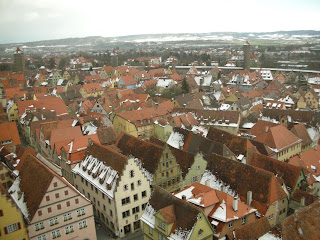
One of the entrances to the medieval town, from the direction of the Bahnhof
 The pavement of the Altstadt is preserved to the extent that the lanes are cobbled, stoned, and uneven.
The pavement of the Altstadt is preserved to the extent that the lanes are cobbled, stoned, and uneven.  The Rathaus on the left. It looks like some cartoon Flintstone house, that you see in fairy tales.
The Rathaus on the left. It looks like some cartoon Flintstone house, that you see in fairy tales.
 The medieval houses are magnificantly picturesque and tastefully painted with pastel colours.
The medieval houses are magnificantly picturesque and tastefully painted with pastel colours. The view from the Rathaus
In order to get the best view of the town, I climbed up the Rathaus and squeezed myself into a small exit at the top of the Rathaus. From the top I could see the whole town and the town walls that enclose the town. It was a wonderful sight as the pictures below testify. Moreover the snow that was sliding or beginning to melt on the roofs added more taste to the photos:
The same view as the previous picture except this time from the top of the Rathaus.

Unlike the town wall in Nürnberg which was actually a replica of the old town wall that was destroyed by the Allies in Jan 1945, the town wall at Rothenburg ob der Tauber is original. It has existed since the 13th century. How is it so that the town was spared from the Allies during WW2? It turns out that actually Nazis were sent to defend the town during WW2 and the Allies were on the verge of completely flattening the town. In fact, it was mentioned that quite a signifiant proportion of the whole town was damaged, slightly less than 50%, but the Altstadt emerged relatively unscared. But what was more important was that the US Assistant Secetary of War John McCloy understood the historic importance and beauty of the town and so he ordered the military not to fire artillery shells at the town, thereby preserving the town but capturing it using other means.
 I am not sure if the cannons here are from medieval times as well.
I am not sure if the cannons here are from medieval times as well.

http://picasaweb.google.com/vintagebin/25MarRothenburgObDerTauber


No comments:
Post a Comment